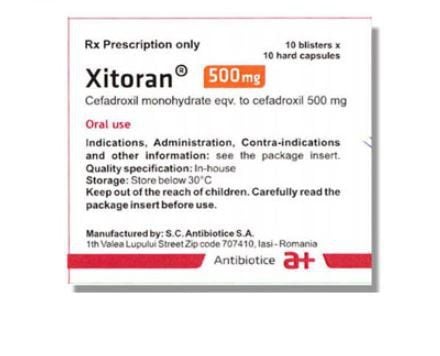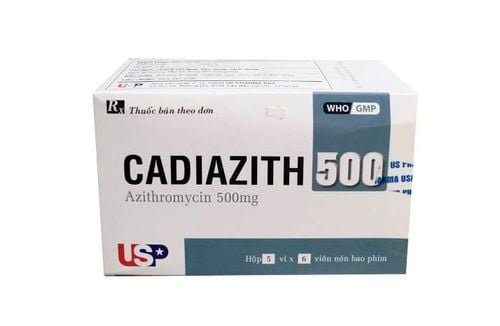This is an automatically translated article.
Aziflam is indicated for infections caused by bacteria that are sensitive to the drug or need to treat sexually transmitted infections in both men and women. In this article, we will learn more about Aziflam's uses and special notes.
1. What is Aziflam?
Aziflam is a prescription drug, with the main ingredient Azithromycin, manufactured by Flamingo Pharm., Ltd - India.
Pharmaceutical name: Aziflam drug. Group of drugs: Belongs to the group of antiviral drugs, antifungal drugs, antiparasitic drugs, anti-infective drugs. Ingredients: Azithromycin. Dosage form: Capsules. Packing: Packed in a box of 2 blisters, each blister contains 3 tablets. Registration number: VN-8589-04. Production unit: Flamingo Pharm., Ltd - India. Registrant: Registered by Thang Loi Pharmaceutical Co., Ltd.
2. What are the uses of Aziflam?
Azithromycin is an active ingredient with a mechanism of action through binding to the 50S subunit of the ribosome, thereby inhibiting the protein synthesis of bacteria. Besides, Azithromycin also has a broad antibacterial spectrum, peak plasma concentrations are reached 2 - 3 hours after oral administration.Pharmacokinetic studies have shown that the concentration of Azithromycin in tissues is higher than in plasma (up to 50 times). Concentrations in tissues such as tonsils, lungs or prostate exceed MIC90 values in various bacteria following a single 500 mg dose.
Thanks to the above effects, Aziflam is indicated for use in cases such as:
Cases where the patient has an infection caused by bacteria sensitive to the drug such as: Lower respiratory tract infection (including pneumonia , bronchitis ); various forms of skin and soft tissue infections; upper respiratory tract infections such as tonsillitis , pharyngitis , sinusitis ; otitis media. Azithromycin should only be used in patients who are allergic to penicillin, because of the risk of resistance. In sexually transmitted infections in both men and women, Azithromycin is used to treat uncomplicated genital infections caused by Chlamydia trachomatis or non-multiresistant Neisseria gonorrhoeae.
3. Dosage and how to use Aziflam
3.1. Dosage of Aziflam For adults:
Treatment of sexually transmitted infections such as cervicitis or urethritis caused by Chlamydia trachomatis infection with a single dose of 1g. Other indications (including pharyngitis, pneumonia, bronchitis, skin and soft tissue infections): First day use 1 dose of 500mg, use continuously for the next 4 days with a single dose of 250mg/day. For young children:
Suggested dose for children in the first day is 10mg/kg body weight, the next dose is 5mg/kg body weight/day, from day 2 to day 5 give children 1 time/day. 3.2. How to use Aziflam Azithromycin is indicated for use once a day, taken 1 hour before meals or 2 hours after meals. Because food has the ability to reduce the absorption of the drug, it is therefore not advisable to take the drug with food.
4. Precautions when using Aziflam
4.1. Contraindications Aziflam Do not use for patients who are allergic or hypersensitive to Azithromycin or any antibiotic of the macrolide group.
4.2. Aziflam drug side effects During the use of Azithromycin, patients are likely to experience some unwanted side effects such as:
Headache, abdominal pain, nausea, vomiting, diarrhea, dizziness, fainting , heart palpitations, severe diarrhea (watery or bloody stools), with or without fever and stomach pain (many reported cases may persist for more than 2 months after drug discontinuation). Hives, rash, itching, swelling of the face, throat, lips, tongue, eyes, hands, feet, ankles or legs, wheezing, trouble breathing or swallowing, hoarseness, mouth sores. Yellow skin, dizziness, drowsiness, extreme fatigue, lack of energy, loss of appetite, unusual bleeding or bruising, pain in the upper right part of the stomach. Flu-like symptoms, blistering or peeling of the skin, dark urine, unusual muscle weakness or difficulty controlling muscles. In addition to the above symptoms, Azithromycin can cause many other unusual signs. Patients should call their doctor immediately if they see any other abnormality while taking the drug.
4.3. Drug Interactions Because food can reduce the bioavailability of the drug by up to 50%, Azithromycin is indicated to be taken only 1 hour before a meal or 2 hours after a meal. Do not combine Azithromycin with ergot derivatives, because it has the potential to cause poisoning. In cases where it is necessary to co-administer with antacids, Azithromycin should only be taken at least 1 hour or 2 hours after the patient has taken the antacid. Results from pharmacokinetic studies in healthy volunteers showed no significant effect on plasma concentrations of carbamazepine or its metabolites. The study showed that the pharmacokinetics of Azithromycin was not affected if the patient took a dose of Cimetidine 2 hours before taking Azithromycin. Some macrolide antibiotics interfere with the metabolism of Cyclosporin, so it is necessary to closely monitor the concentration and adjust the dose of Cyclosporin accordingly. In some patients, Azithromycin may interfere with the metabolism of Digoxin in the intestine. Therefore, if using these two drugs at the same time, the patient should be monitored for Digoxin levels, because it is likely to increase Digoxin levels. Studies performed in healthy volunteers have shown that Azithromycin has no significant effect on the pharmacokinetics of methylprednisolone. With regard to theophylline, no effect on the pharmacokinetics of the co-administration of azithromycin with azithromycin has been observed in healthy volunteers; however, it is generally advisable to monitor theophylline concentrations when co-administered with theophylline. In a pharmacokinetic study in healthy volunteers given a single 15 mg dose of Warfarin, Azithromycin had no effect on anticoagulant activity. Both drugs can be used at the same time, but the patient's blood clotting time should still be monitored. 4.4. Caution when using Aziflam Special care should be taken when using Azithromycin and other Macrolides, because the potential for allergic reactions such as anaphylaxis, angioedema is quite dangerous (although rare). Similar to other antibiotics, during use, patients need to watch for signs of superinfection, caused by bacteria that are not sensitive to the drug, including fungi. In case the patient has kidney disease and has a creatinine clearance <40ml/min, the dosage should be adjusted accordingly. Especially do not use the drug for people with liver disease, because the main route of elimination of the drug is through the liver. Above is important information about the effects of Aziflam with detailed notes when using. However, to ensure the safety and effectiveness of the drug, patients should only use it when prescribed and guided by a doctor or medical staff.













